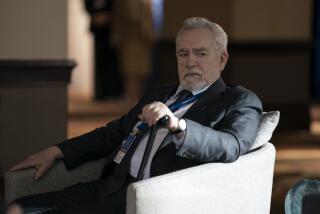PROFILE : New Man at McDonnell Douglas : Transition: Harry Stonecipher turned Sundstrand around. Analysts expect him to shake things up in his new job too.
- Share via
For clues about how Harry C. Stonecipher is going to run McDonnell Douglas Corp., the best place to start is the seven years he spent in Rockford, Ill., running a large but bland aerospace company known as Sundstrand Corp.
Stonecipher arrived as Sundstrand’s president in 1987, just as the maker of aircraft and industrial parts was in trouble with the Pentagon for price fraud. It had other problems as well: excessive debt, dwindling profit, overreliance on the slumping defense and aerospace industries.
After being named chief executive in 1988, Stonecipher slashed Sundstrand’s employment by a third to lower its costs. He sold off weak divisions, reorganized those he kept and bought new firms to build up Sundstrand’s non-aerospace industrial operations.
In the process, Stonecipher pared Sundstrand’s debt, bolstered its profit margins and nearly doubled the company’s stock price from four years earlier. He took care of the parts scandal by having the firm plead guilty and pay $200 million in fines.
All of which is persuading analysts that McDonnell Douglas is also in for major changes under Stonecipher, 58, who was named president and chief executive earlier this week. McDonnell Douglas is the nation’s largest defense contractor, with $14.5 billion in annual sales and 67,000 employees, including 20,000 in Long Beach.
“He is going to shake the place up,” predicted C. Donald Scales, aerospace manager for EDS Management Consulting Services in Los Angeles.
That’s just what McDonnell Douglas can use, Scales said, because the St. Louis-based firm faces several nagging strategic challenges--such as its C-17 military transport plane and its troubled commercial jetliner group--that need a fresh review.
Even Chairman John F. McDonnell, who at age 56 surprised many by relinquishing the chief executive’s job to Stonecipher, said McDonnell Douglas’ turbulent ride in recent years has left many of his workers demoralized and tentative.
“We needed a leader who will get everybody back up on the step, excited about the future,” McDonnell said in a telephone interview.
Based on his Sundstrand stint, Stonecipher fits the bill. He is known as a determined, blunt, strong-minded and energetic executive who works long hours and has a deft touch for promoting his goods to potential customers.
His image stands in bright contrast to the bearded, bookish-looking McDonnell, an intelligent but reserved Princeton-educated engineer who said he wanted Stonecipher to run McDonnell Douglas so he could think about its long-term future.
Sundstrand spokesman Brad Considine recalled how, back in 1988 when Sundstrand was in trouble, he would routinely arrive at work at 6:30 a.m. and see Stonecipher’s white Lincoln already parked in front of the building.
“I was keeping long hours myself, and I remember leaving (at night) and feeling I’d put in a long day,” Considine said. “But on the way out, I’d see that white Lincoln still in the parking lot.”
A stocky six-footer who wears steel-rimmed glasses and earned a physics degree from Tennessee Technological University, Stonecipher is described as a personable man who likes his subordinates to call him Harry.
He was also known as a community activist who, in his seven years at Sundstrand, persuaded its employees to more than double their annual donations to United Way.
“He doesn’t lack for competitive juices,” said Chuck Chadwell, vice president for production at General Electric Co.’s aircraft engines group, where Stonecipher spent 26 years and rose to senior management before joining Sundstrand.
“He also has a good sense of humor,” Chadwell said, “but he’s tough-minded as hell when he needs to be.”
Stonecipher will need to be tough-minded at McDonnell Douglas, a company with sales 10 times those of Sundstrand’s.
McDonnell Douglas has completed a strong financial comeback since 1992, but only after John McDonnell led the firm through a wrenching cost-cutting and restructuring program that slashed employment by more than half in the last four years.
The cuts mirrored those made by other defense firms as they grappled with smaller defense budgets. But now that much of the cutting appears over, McDonnell Douglas still faces nettlesome questions about what its business will look like during the next decade.
Some of its big programs, such as the F/A-18 jet fighter, have relatively secure futures. Others do not.
McDonnell Douglas’ C-17 program in Long Beach could end with just 40 planes. Its missile business, having lost a $1-billion Navy contract to Hughes Aircraft Co. earlier this month, “no longer has critical mass” and might have to be sold, Morgan Stanley & Co. defense analyst Phil Friedman said in a recent report. The commercial jetliner group, also in Long Beach, desperately needs new orders.
McDonnell Douglas overall has also been largely absent from the defense industry’s recent merger wave. “They’ve been so focused on survival . . . that their ability to do deals has been extraordinarily limited,” Scales said.
But Stonecipher’s record at Sundstrand shows he’s generally averse to nursing along sick divisions for lengthy periods, preferring instead to shed them and buy other, more promising businesses.
It’s a strategy partly honed by his years at GE, the diversified manufacturing giant whose chairman, Jack Welch, is renowned for his philosophy of relentless cost cutting and of selling divisions that aren’t leaders in their markets.
Stonecipher “would tell you straight out that Jack Welch was an influence on him,” Considine said. “But I’d also say he is very much his own person.”
More to Read
Inside the business of entertainment
The Wide Shot brings you news, analysis and insights on everything from streaming wars to production — and what it all means for the future.
You may occasionally receive promotional content from the Los Angeles Times.











